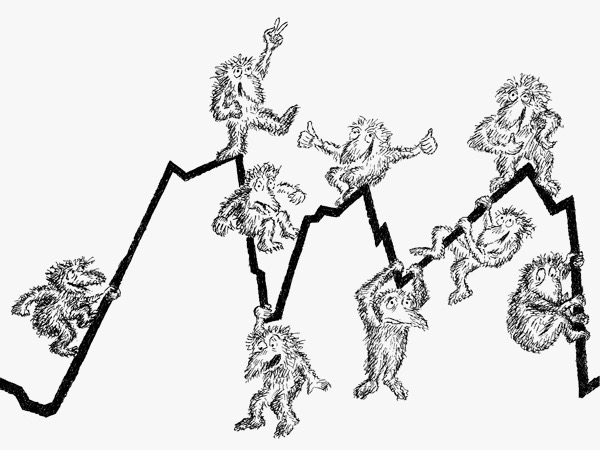If the hypothesis proposed last June [https://gapthinking.ca/an-hypothesis/] remains tenable, and I think it does, interesting questions result. The observed change in the animal spirits governing global financial markets may mark the end of an era, and per force, the beginning of a new era.
At its core, the hypothesis and the following speculative fiction suggest a meaningful probability that the “Big Discount Rate” which declined precipitously between 1981 and 2016 [old era] finally began to rise in January, 2018. The market price of every asset is determined by its own unique Little Discount Rate which varies according to perceived risks and market enthusiasms. Little Discount Rates are tethered – sometimes tightly and sometimes loosely – to Big DR. If Big DR rises [new era], the value of all future cash flows will decline – stocks, bonds, real estate, et al.
Irrespective of the odds one places on Big DR rising, there is embedded a second order speculation. Like every attempt at understanding the world, economic and financial analysis rests on commonly accepted “truths” or paradigms. Unlike the sciences, financial paradigms are not subject to verification. They, in fact, are hardened by repetition in academia and the media. The true speculation here is that IF the Big DR rises substantially, many of the currently accepted “truths” will be found wanting, and many Emperors will prove naked. The unveiling could be ugly!
What is the evidence of a January 2018 change in animal spirits [sentiment, zeitgeist]? Emerging markets have been pummelled. Major stock markets, with the exception of the US, are below January levels. Interest rates are up, and more importantly, rates on acknowledged lower quality credits are up more. Prices of industrial commodities like copper and lumber are sharply lower. Crude oil, affected by imploding Venezuela and impending sanctions on Iran, is the exception. Hedge funds have been experiencing withdrawals and several have closed. Qualitatively, it seems the game is changing. A probabilistic judgement – 60/40, 75/25?
What were some important characteristics of the just-ended era [1981 – 2017]?
- Most importantly, interest rates declined for two generations, long enough to solidify the worldview of all but the most ancient. Except for transitory episodes, interest rates are benign.
- Debt finance became prudent! And the more, the better. Measured any way – for governments, companies and individuals – over that forty year period, the amount of debt outstanding more than doubled as a proportion of assets or income.
- Stock market valuation parameters more than doubled. Price-earnings multiples advanced from below 10 to above 20 currently for the US stock averages.
- Central Banks stood by to manage all financial markets. Starting with Alan Greenspan’s response to the decline in 1987, and consistently through the period of Quantitative Ease, 2009-2018, authorities have been quick to support any market in difficulty.
- Structured Investment Products came to dominate all financial markets – even the most illiquid little corners. Individual investors and even many institutional professionals abrogated responsibility in favour of index funds or black box alternative strategies.
- A feature of this period of declining discount rates was that fear of unrecoverable loss virtually disappeared. “Risk” morphed into volatility – a feature of financial products to be managed using appropriate derivative instruments.
Sooo, what might the next era become? Looking back from 2038, we will probably see:
- Those dominant trends of the last two generations will have moderated. Interest rates will certainly be higher and the value of all cash flows will be lower.
- The era will not be kind to dogmatic adherence to mantras (Stocks always go up; to get more return, take more risk; as you age, more fixed income, etc).
- Creators and purveyors of Alternatives and Structured Products will fare poorly – although still better than their customers.
- Paradigms create their own vocabulary. Many of the all-embracing big words of the last era are likely to be redefined or repurposed: Capitalism, Inflation, Volatility, Risk are among my candidates, but more of that later.
- Having used up all their firepower, Central Bankers will have become onlookers.
- The lurid legacy of leverage will have paled. Debt levels will have reverted to manageable levels in relation to sustainable cash supports. Throughout history, governments in extremis have found ways to default – a process that will be easier since so much national debt is now held by the Central Banks. Over-exuberant borrowers and imprudent lenders will see their stakes much diminished.
How might we get from here to there?
- Logically, and thoroughly supported by Ray Dalio’s recent work on Big Debt Crises, the outcome of such a massively indebted global economy is either protracted inflation or deflation. His analysis of 48 instances in the last 100 years had 21 deflationary and 27 inflationary outcomes – close enough to 50/50 for our purposes.
- In the early stages of this new era, fear of financial problems will likely interact with political expediency [QE5, 6?] to create vivid mood-swings. Animal spirits will be very active.
- After three or four years of buffeting between the “Forces of ‘Flation”, the glide path may be reasonably well defined – unlikely before then. Buckle up!
- Political solutions are not available. The ammunition of fiscal and monetary policy has been spent. All that remains is moral suasion, and even then we seem cursed with more suasion than moral.
Be alert, be flexible and wary of Emperors.
